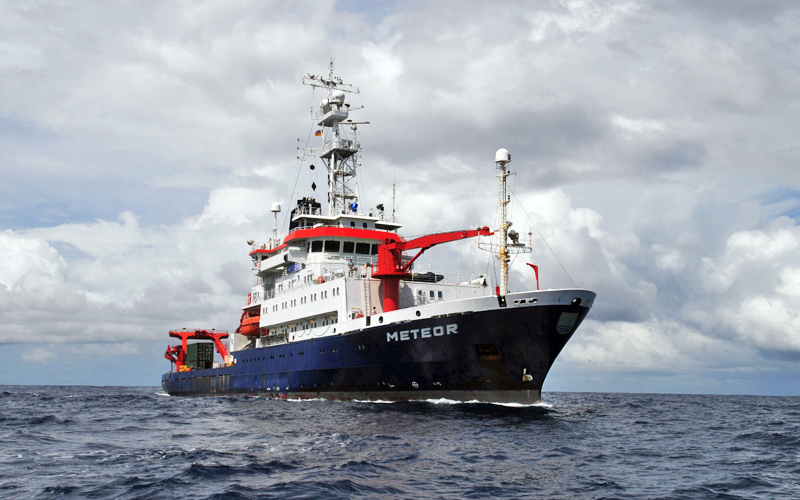METEOR M160
- Area:
- Northeast of the Cape Verde Archipelago
- Time:
-
22.11.2019 - 20.12.2019
- Institution:
- GEOMAR
- Chief scientist:
- Arne Körtzinger
Cruise M160 (MOSES Eddy Study II) aims to carry out a detailed high-resolution, multi-parameter study of individual eddies in the tropical northern Atlantic. Eddies are generated off West Africa throughout the year with a peak in frequency during summer. At an average propagation speed of 3.0±2.5 km per day along their typical westward trajectories this peak in eddy abundance has reached the region to the northeast of the Cabo Verdean archipelago by November/December. This time window therefore provides the highest likelihood for encountering strong eddies in the working area. Parallel to the ship expedition the Stemme S10 VTX motorglider of the Aachen University of Applied Sciences will be used for parallel airborne observations of sub-mesoscale eddy features. The ambitious eddy study follows an approach demonstrated successfully during the 2014 “Eddy Hunt Project” (GEOMAR & Kiel University) combined with the successful approaches of the sub-mesoscale experiments SubEx I and II and the “Expedition Clockwork Ocean” (HZG). Using refined and proven automated detection methods employing remote sensing products (sea level anomaly, sea surface temperature, ocean colour) an early detection of eddies will be possible during the months preceding the cruise. For groundtruthing of potential candidate eddies, ocean gliders will be deployed from the Ocean Science Centre Mindelo (www.oscm.cv, São Vincente island, Cabo Verde) prior to the cruise. Two gliders carrying an extended sensor suite (CTD, oxygen, chlorophyll, turbidity) will be steered towards the candidate eddies for a remote hydrographic survey. The glider data will allow to unanimously prove (or disprove) the features of the potential eddy candidates. Eddies that are confirmed to have strong and clear signatures will then be selected for detailed study during M160.
We will be able to carry out a detailed study of two individual eddies selected through the early detection and verification scheme described above. The type of eddy (cyclonic, anticyclonic, anticyclonic mode water) will be known on the basis of the pre-cruise remote sensing and in-situ observations. While anti-cyclonic mode-water eddies (ACME) perhaps host the most extreme properties, all three eddy types are of interest in this study as they will exert a very different forcing on the physical and biogeochemical system and hence the biological pump. It is very unlikely that the two neighbouring eddies to be studied during M160 are of the same type adding to the breadth of the survey. In all eddies it is expected that the largest gradients of the mesoscale eddy are located just beneath the mixed layer at a depth of approx. 100 m, while intense sub-mesoscale activity is ex-pected in the surface layer above the mesoscale core. Special attention will be given to the rim of the eddy where strong ver-tical sub-mesoscale motion may be concen-trated in sharp fronts at the surface connect-ing matter exchange with the mesoscale top cap and core. Elucidating these contrasting roles by connecting the large range of rele-vant scales is a major and novel aim of the study.



